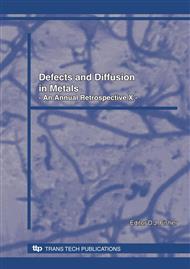p.1
p.11
p.15
p.25
p.33
p.45
p.55
Effect of Irradiation Doses on AlCu6.5 Alloy Using Positron Annihilation Doppler Broadening Technique
Abstract:
Positron Annihilation Spectroscopy (PAS) is a powerful and versatile tool for the study of the microscopic structure of materials. Doppler Broadening Positron Annihilation Technique (DBPAT) is the fastest technique used among positron annihilation techniques. The dose effect in Al-6.5at. % Cu alloy was investigated by means of DBPAT. An abrupt change in both the S and W line-shape parameter values occurred at 70 kGy of irradiation. The S- and W-Parameters of the trapped positrons at 70 kGy of γ−irradiation dose are about 48 % and 14 % respectively. The S- versus W-parameter reveals a linear relationship indicating the presence of only one type of defect. The S- and W-parameters have been used in the determination of the positron trapping rate and the grain size of the AlCu6.5 alloy.
Info:
Periodical:
Pages:
15-24
Citation:
Online since:
July 2008
Authors:
Price:
Сopyright:
© 2008 Trans Tech Publications Ltd. All Rights Reserved
Share:
Citation:


